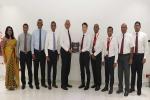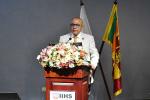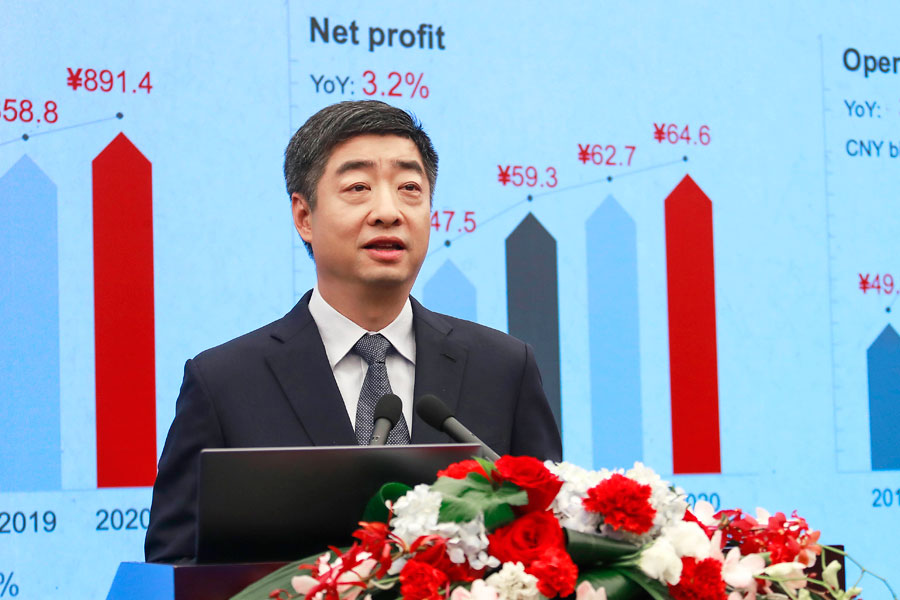The amounts were converted into USD using the December 31, 2020 closing rate of US$1.00 = CNY6.5198, and EUR amounts are translated using the December 31, 2020 closing rate of EUR1.00 = CNY8.0235.
Figures have been rounded to the nearest CNY/US$0.1 billion. Unless otherwise specified, business figures are data for the end of 2020.)
I. Financial Figures
1. Total revenue: CNY891.4 billion (US$136.7 billion), up 3.8% YoY
(1) Revenue by BG:

Note: Revenue from other business totaled CNY5.5 billion (US$0.8 billion). Revenue from the cloud & computing business was included in the carrier and enterprise business revenue.
(2) Revenue by region:

Note: Revenue from other geographic markets totaled CNY21.6 billion (US$3.3 billion).
Revenue from markets outside China accounted for approximately 31.9% of the total, and revenue from China accounted for approximately 65.6% of the total.
2. Net profit: CNY64.6 billion (US$9.9 billion), up 3.2% YoY; net profit margin: 7.3%
3. Cash flow from operating activities: CNY35.2 billion (US$5.4 billion), down 61.5% YoY
4. Cash and short-term investments: CNY357.4 billion (US$54.8 billion), down 3.7% YoY
II. Business Highlights
1. Carrier Market
(1) Supported the stable operation of 1,500+ carrier networks across 170+ countries and regions.
(2) Multiple third-party test reports on 5G network experience in large cities ranked Huawei's 5G networks top.
(3) The FDD Massive MIMO solution was deployed by 50+ carriers around the world, maximizing capacity gains.
(4) Participated in 3,000+ innovation projects worldwide and worked with carriers and partners to sign 1,000+ 5GtoB project contracts, spanning 20+ industries.
(5) Provided training to over 1.5 million digital professionals from 260+ carriers around the world.
(6) Leveraged digital technologies and contactless online delivery solutions based on the Integrated Service Delivery Platform (ISDP) to enable online collaboration with customers and partners and maintain uninterrupted delivery, and successfully delivered over 2 million sites in 2020.
(7) Helped 40+ carriers launch 5G FWA services, connecting 800,000+ households. These services deliver fiber-level network speeds, and have become a key method for carriers to quickly expand their share in the home broadband market.
(8) Innovative AirPON solution: Leveraged wireless sites and optical fiber resources to make site acquisition much easier and support quick home network coverage; commercially deployed by 30+ carriers worldwide.
(9) RuralStar series solutions: Provided mobile Internet services to 50+ million people living in remote areas in 60+ countries and regions.
2. Enterprise Market
(1) 700+ cities and 253 Fortune Global 500 companies chose Huawei as their partner for digital transformation.
(2) Consistently implemented fair, just, transparent, and simple policies that benefit our partners, and continually collaborated and shared value with them. Worked with 30,000+ partners to serve the enterprise market by the end of 2020, including 22,000+ sales partners, 1,600+ solution partners, 5,400+ service and operation partners, and 1,600+ talent alliances.
(3) Worked with partners to explore and apply Intelligent Twins in 600+ scenarios, covering sectors such as government, public utilities, transportation, manufacturing, energy, finance, healthcare, and scientific research.
(4) Smart cities: Huawei's smart city solutions were deployed in 700+ cities across 40+ countries and regions; between September and December 2020, Huawei announced partnerships to build City Intelligent Twins with multiple cities across China, including Shenzhen, Chengdu, Fuzhou, Nanchang, Changchun, Harbin, and Shanghai, setting a new precedent for the all-scenario intelligence of cities.
(5) Finance: Served 2,000+ financial institutions from 60+ countries and regions, including 47 of the world's top 100 banks.
(6) Transportation: Developed a set of comprehensive solutions for the transportation sector that pave the way for the digital transformation of six industry verticals: smart aviation, smart urban rail, smart highways, smart logistics, smart railways, and smart ports.
In aviation, Huawei served 100+ airports across 40+ countries and regions. In rail transport, Huawei's smart urban rail solution served 200+ urban rail lines in 70+ cities worldwide.
(7) Energy: Established extensive partnerships with 190+ electric power companies worldwide, and provided digital services to 17 of the world's top 20 oil and gas companies and 17 of the world's top 20 mining companies.
(8) Higher education: Helped 2,600+ universities and research institutes in 70+ countries and regions explore the unknown; basic education: Actively promoted digital transformation worldwide, and provided education cloud platform services for elementary and secondary schools, based on HUAWEI CLOUD, which benefited 50+ million students who could not attend school due to COVID-19.
(9) Healthcare: Helped 1,500+ hospitals in countries including China, Turkey, Indonesia, and Germany increase their use of digital technology and provide smart healthcare services.
(10) Internet: Provided Internet connectivity, data center infrastructure, and HUAWEI CLOUD solutions to 2,100+ Internet companies worldwide.
(11) Intelligent campuses: Served 500+ customers across numerous sectors such as government, energy, manufacturing, real estate, and logistics, helping their campuses achieve all-scenario intelligence.
(12) Data centers: Data center infrastructure adopted by 12,000+ customers worldwide in industries including government, finance, energy, and transportation, helping customers upgrade to intelligent business systems
(13) 400,000+ engineers received a Huawei Certification, with 13,000+ of them receiving the Huawei Certified ICT Expert (HCIE) certification, providing a valuable resource pool to support industry digitalization worldwide.
(14) Provided consistent, high-quality services to 50,000+ customers worldwide, improving their O&M efficiency and system availability.
Completed 130,000+ projects, including 600+ key projects, and supported the secure and stable operation of 500+ key customer networks.
3. Connectivity
(1) Networks built by Huawei have proven instrumental to many carriers' best-in-class performance in LTE/5G network assessments.
Huawei ranked first in all criteria categories of GlobalData assessments on 5G RAN and LTE RAN, and was once again named the leader.
(2) PowerStar solution: Commercialized in 400,000+ sites across China to help customers save 200 million kWh of electricity each year.
(3) Liquid OTN solution: Reduced latency by 30% and provided 100 times more bandwidth than the older-generation hard pipe technology.
(4) AirPON solution: Allowed carriers to use their existing wireless sites, thus making network construction more efficient, cutting network construction costs by 30%, and shortening the time to market (TTM) by 70%.
(5) IPv6+: Proactively pushed the IPv6+ industry forward and contributed more than 70 standards documents in cooperation with industry partners and standards organizations.
(6) Cloud core networks: Continuously contributed to standards organizations and led the way in the industry; largest contributor to 3GPP SA2, CT R16, and CT R17 standards, responsible for 20%+ of all contributions.
4. Cloud & Computing
(1) HUAWEI CLOUD: Launched 220+ cloud services and 210 solutions, and earned over 80 industry-recognized security certifications worldwide; works with 19,000+ partners and has brought together 1.6 million developers. 4,000+ applications launched on the HUAWEI CLOUD Marketplace.
(2) The China Cloud Services Market Q4 2020 report released in March 2021 by Canalys ranked HUAWEI CLOUD second in China with a market share of 17.4%.
(3) HUAWEI CLOUD operates 45 availability zones with partners in 23 regions around the world.
(4) Remained committed to its strategy of open hardware, open-source software, and partner enablement. Certified thousands of partner solutions using Kunpeng and Ascend. 430,000+ Kunpeng and Ascend developers.
5. Device Business
(1) Over 1 billion connected Huawei devices worldwide; 730+ million Huawei smartphone users.
(2) App ecosystem: 120,000+ apps worldwide integrated with HMS Core; 2.3+ million registered developers worldwide, including 300,000 developers outside China.
The number of apps launched on AppGallery in 2020 outside China was more than 10 times that of 2019. HMS is now the world's third largest mobile app ecosystem.
(3) Smart home ecosystem: The Huawei HiLink ecosystem had worked with 600+ mainstream home appliance brands, covering 3,000+ products and serving 50+ million users.
The HUAWEI AI Life app had 54+ million active users, who submitted over 1.08 billion requests every day.
(4) HarmonyOS app development: 120+ mainstream apps, including JD.com, Baidu, Youku, and iFLYTEK, started innovating based on HarmonyOS in order to bring consumers a completely new, intelligent experience.
(5) Nearly 60,000 retail stores, display zones, and display counters established around the world, including 5,000+ experience stores
(6) Customer service: Remained committed to building and improving basic service capabilities by focusing on three service platforms: offline services, online services, and self-service.
Provided services to 57+ million consumers in 2020, and used AI technologies to pursue transformation towards intelligent customer services, allowing Huawei to accept 25+ million consumer inquiries through robots.
6. Intelligent Automotive Solution Business
(1) Working with 100+ ecosystem partners, such as car OEMs, software and hardware component providers, developers, and industry organizations.
(2) Will soon launch 30+ intelligent components based on an open "computing + communications architecture" (CCA) and digital platforms.
7. Huawei has been evaluated and certified by multiple independent third parties, receiving the following certifications:
ISO 9001 (quality management)
TL 9000 (quality management for the ICT industry)
IATF 16949 (quality management for the automotive industry)
ISO 14001 (environmental management)
ISO 14064-1 (quantification and reporting of greenhouse gas emissions and removals)
OHSAS 18001/ISO 45001 (occupational health and safety management)
IECQ QC 080000 (hazardous substance process management)
ISO 50001 (energy management)
ISO 22301 (BCM)
ISO/IEC 20000-1 (IT service management)
ISO/IEC 27001 (information security management)
ISO 28000 (security management for the supply chain)
ISO/IEC 27017 (cloud security management)
ISO/IEC 27018 (protection of personally identifiable information in public clouds)
ISO/IEC 27701 (privacy information management)
ISO/IEC 29151 (protection of personally identifiable information)
CSA STAR (cloud security management)
PCI DSS and PCI 3DS (payment card industry data security)
SOC 1, 2, and 3 (system and organization controls)
ISO 27799 (health information security)
TISAX (information security and trusted information exchange in the automotive industry)
NIST CSF (cyber security framework)
III. Research and Innovation
1. Has consistently invested over 10% of our sales revenue into R&D every year. R&D expenditure in 2020 totaled CNY141.9 billion (US$21.8 billion), accounting for 15.9% of the company's total revenue. R&D investment over the past decade has exceeded CNY720 billion (US$110 billion).
2. Has one of the largest patent portfolios in the world. Held a total of 100,000+ active patents across 40,000+ families by the end of 2020.
IV. Openness. Collaboration. Shared Success
1. An active member of 600+ industry organizations, including standards organizations, industry alliances, open source communities, and academic associations, where Huawei holds 400+ key positions. Serves as a member of the board or executive committee in 3GPP, ETSI, IETF, IIC, IEEE SA, the Linux Foundation, CCSA, AII, TM Forum, WFA, WWRF, CNCF, OpenInfra (formerly OpenStack), LFN, LFDL, IFAA, GP, CUVA, VRIF, and BBF.
2. Contributes to 200+ standards organizations on an ongoing basis; have submitted over 65,000 standards contributions. Helps to drive technological progress and carry global industry forward by working closely with key international standards organizations.
3. An active contributor to leading open source communities; among the top 10 code contributors in these communities worldwide; the No. 1 code contributor in Asia Pacific.
4. An active partner in major industry alliances such as GSMA, ITU, AII, 5GAA, and ECC. Currently involved in 30+ industry projects. Actively contributes white papers and test beds.
5. Published 590+ journal and conference papers in high-impact channels like the ACM and IEEE. 90+ of Huawei's technical experts have served as peer reviewers for scientific journals and conferences.
6. Continued to expand our ecosystems, deepening and expanding our relationships with solution partners worldwide. Added 5,000+ registered partners worldwide in 2020. Launched 2,000+ joint solutions with 1,600+ partners.
7. Building up developer ecosystems revolving around HUAWEI CLOUD, Kunpeng, and Ascend. 2+ million developers in the ICT sector registered with Huawei.
8. Officially launched HMS Core 5.0 in June 2020, which opened up 50+ kits and nearly 13,000 APIs to global developers. This means that Huawei's software, hardware, and cloud capabilities are now available for developers to use.
V. Figures Concerning Employees
1. Total headcount: ~197,000. About 105,000 employees working in R&D, accounting for about 53.4% of our total workforce.
2. Number of employees involved in the Employee Shareholding Scheme: 121,269. Investment from Mr. Ren Zhengfei as a percentage of the company's total share capital (as of December 31, 2020): 0.90%
3. Global employee benefits in 2020: About CNY11.9 billion (US$1.8 billion)






















